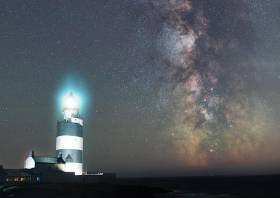Displaying items by tag: Hook Lighthouse
On the coastal narrow road to Hook Lighthouse in Co. Wexford was lined with sea foam as cars arrived on New Year’s Day from 7.30 a.m. for a ceremony that dates back to 1687.
An outcrop of rock behind the 800-year-old Hook Lighthouse was the destination for the Dunbrody Archers, New Ross Municipal District officials and some curious onlookers, all braving the cold to witness a spectacular start to 2022.
The tradition dates from 1687 when the mayor and the corporation of New Ross Town Council claimed their authority over the waters by travelling to Hook and shooting an arrow into the sea from Hook Head Lighthouse.
The Mayor of New Ross, casting the arrow into the sea, symbolises the port of New Ross’s authority over the estuary of the Barrow and the Suir all the way down to Hook Head.
More from the New Ross Standard on the event from the south-east.
#Lighthouses - The most spectacular meteor shower of the year takes place in Ireland each August – and Hook Lighthouse will be the place to see it.
At the world’s oldest original working lighthouse, the dark skies at the tip of the Hook Peninsula underneath the beam of the lighthouse tower offer spectacular views of the constellations and the night skies.
On Saturday 11 August the Lighthouse Visitor Centre will remain open extra late to offer a stargazing evening event to visitors who want to see the Perseids meteor showers like they’ve never been seen before.
Joining the team at Hook Lighthouse to guide the event is special guest astronomer from Big Bear Planetariums, Carl O’Beirnes.
Carl will be on hand to open the evening advising visitors on what to look out for and how to identify the constellations in the night sky.
He will also offer visitors the opportunity to view the planets and deep sky objects visible during the meteor shower via telescopes and share details on how to photograph the night sky and the milky way galaxy.
Carl advises that visitors bring their telescopes and cameras if they wish, but no equipment at all is required for those who wish to relax and enjoy the best movie that nature can offer.
Visitors are advised to dress warmly and to bring deck chairs and blankets as the temperature will drop as the night progresses.
This is a free event and those attending are invited to find a spot on the lighthouse lawns from 7pm to gaze skyward for shooting stars.
The Perseids are created when the Earth crosses the tail of Swift-Tuttle, a comet which takes 133 years to orbit the sun. Meteors are created when tiny flecks of dust and debris from the comet penetrate the Earth’s atmosphere at nearly 60 kilometres per second creating a shockwave. They burn up quickly in the atmosphere leaving the impression of a huge fireball.
The lighthouse will remain open until 11pm offering hot chocolates and snacks at the café. For further details visit www.hookheritage.ie
Hook Lighthouse Gives Inspiration to Young Wexford Artist
This painting of the Hook Head Lighthouse is one of many with a nautical theme submitted for judging in this year’s 62nd Texaco Children’s Art Competition. Appropriately entitled ‘Hook Lighthouse’, it was painted by 15–year–old Emer O’Doherty, a pupil at Gorey Community School.
Viewing the work is Valero Marketing Manager, Bronagh Carron.
Winners of the Competition will be announced in mid-April with prizes being presented in May.
Hook Bass Festival Hopes to Catch Ireland's Best Anglers
#ANGLING - Minister of State Paul Kehoe was on hand at the famous Hook Lighthouse recently to launch the first Hook Bass Angling Festival, which takes places over three days from 26-28 October.
The contest will be held on a catch-and-release basis and comprises various locations on the Hook Peninsula, situated on the amazing southwest Wexford coast, where you can find a beach a day for a fortnight - perfect for the festival.
First prize is a weekend's accommodation at Grangecourt Holiday Cottages in Fethard-On-Sea that sleeps up to five people, plus a day trip fishing for two with Wild Swan, Mermaid Angling, Arthurstown. Prizes will also be awarded for second and third place, and for the longest bass.
Aside from the angling action, the Friday and Saturday evening will see talks from Billy Colfer and Dr Ed Fahy about the history of the area and bass fishing respectively. These will take place at 7pm each evening in Neville’s Bar and Restaurant, which will also be serving a special anglers menu - and will host the prize-giving ceremony on the Sunday evening.
The entry fee for anglers is €75 for the three days days or €25 per day. You can enter online via www.hooktourism.com.
Families are more than welcome, as the Hook Peninsula has many historic sites to see and activities to do, especially for Hallowe'en, such as the 'Ghostly Guided Tours' of Hook Lighthouse. For more information visit www.hooktourism.com.
































































